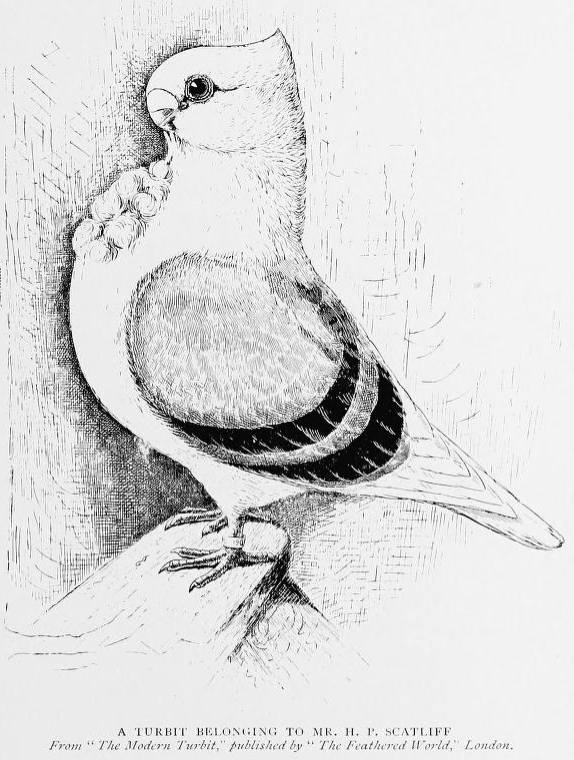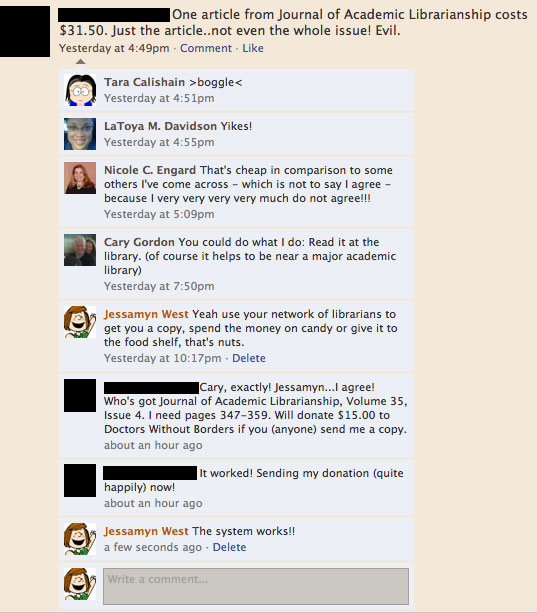It could have been the Avengers of librarianing. All these powerhouses working together to help increase low-income childrens’ access to good reading material. But I don’t think that’s how it worked out. Here are my thoughts on last week’s press releases about this new set of programs. Written for The Message.
Tag: access
asking for what you want, getting what you want
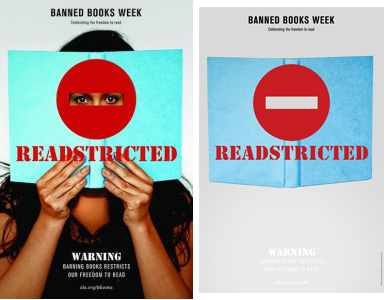
This has been a heady National Library Week for many librarians I know and me in particular. There’s been a lot of online agita and, unlike the way these things usually go, some things wound up changing for the better. Here’s a list. Apologies if I link too much to facebooky stuff.
- Someone mentioned that they found Demco’s “Spanish” spine label a bit troublesome since it had a sombrero and a set of maracas (Mexican, not Spanish, and still stereotypical at that) and misspelled español (without the tilde). A few people complained to Demco. Demco listened, agreed, removed the items from their online store. Not all of their multicultural labels are perfect, but it was nice to be heard.
- ALA’s Banned Books Week poster which was put in the ALA Store this week got a lot of pushback. Does the woman look like she is wearing a niqab? What’s the poster trying to communicate? Andromeda spells out well what some of the issues with the poster are. People wrote to ALA. ALA listened. Took a while to respond. Came back with a few posts from the ALA Office of Intellectual Freedom
- Statement on the 2015 Banned Books Week Poster
- How Do We Design a Banned Books Campaign
- Response Concerning the 2015 Banned Books Week
I particularly found some of the crosstalk interesting about whether objecting to a marketing poster was in the same family as objecting to something being in the library collection. I know we can be a mouthy contentious bunch, but given that, some of this discussion seemed to take place on new ground and it was curious to me how much my years in the MetaFilter trenches has helped me manage these sorts of discussions.
- Daredevil is a great show on Netflix about a blind superhero which did not have any descriptive audio which many found ironic. People complained. The Accessible Netflix Project started a petition. Netflix fixed it.
- After my last post about SpaceX, I decided to expand it into an article for Medium which I did with some nice photos and a lot of linking. A few days later, Flickr actually added an option for users to have public domain and CC0 licenses on their photos. This is, to me, a HUGELY great outcome. I wrote another short article about this.
- On a more personal note, Jason Goldman wrote a post on Medium to talk about how he was going to become the new White House Chief Digital Officer. I left a comment on that article talking about how part of getting people involved in civic engagement is helping them to trust the online world (i.e. doing the opposite of everything Healthcare.gov has done). This comment got a nod in Goldman’s next article now that he’s taken office. I am very very pleased about this.
Bonus link the #journalofneutrallibrarianship hashtag is a pretty good time if you like Twitter. And I wrote a nerdy article about research and Wikipedia that I think you might enjoy if you haven’t seen me blabbing about it all over the place for the past few days.
on public domain and “public domain”
There has been a lot of great writing about copyright and access to our cultural and intellectual history in the weeks since Aaron Swartz’s death. I have been retreading some of my old favorite haunts to see if there was stuff I didn’t know about the status of access to online information especially in the public domain (pre-1923 in the US) era.
I talk like a broken record about how I think the best thing that libraries can do, academic libraries in particular, is to make sure that their public domain content is as freely accessible as possible. This is an affirmative decision that Cornell University made in 2009 and I think it was the right decision at the right time and that more libraries should do this. Some backstory on this.
- Cornell Press release announcing this decision
- Librarian and Policy Advisor Peter Hirtle’s article for Research Library Issues about this decision, Removing All Restrictions: Cornell’s New Policy on Use of Public Domain Reproductions, and the thinking that went into it.
- Cornell’s 70,000 items accessible via the Internet Archive
- Cornell’s guidelines for use of these materials
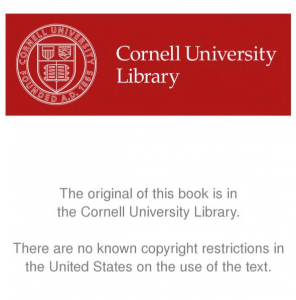 So, if I wanted to share an image from a book that Cornell has made available, I have to check the guidelines link above and then I can link to the image, you can go see it and then you can link to the image and do whatever you want with it, including sell it. This is public domain. The time and money that went into making a digital copy of this image have been borne by the Internet Archive and Cornell University. The rights page on the item itself (which I can download in a variety of formats) is clear and easy to understand.
So, if I wanted to share an image from a book that Cornell has made available, I have to check the guidelines link above and then I can link to the image, you can go see it and then you can link to the image and do whatever you want with it, including sell it. This is public domain. The time and money that went into making a digital copy of this image have been borne by the Internet Archive and Cornell University. The rights page on the item itself (which I can download in a variety of formats) is clear and easy to understand.
Compare and contrast JSTOR. Now let me be clear, I am aware that JSTOR is a (non-profit) business and Cornell is a university and I am not saying that JSTOR should just make all of their public domain things free for everyone (though that would be nice), I am just outlining the differences as I see them in accessing content there. I had heard that there were a lot of journals on JSTOR that were freely available even to unaffiliated people like myself. I decided to go looking for them. I found two different programs, the Register and Read program (where registered users can access a certain number of JSTOR documents for free) and the Early Journal Content program. There’s no front door, that I saw, to the EJC program you have to search JSTOR first and then limit your search to “only content I can access” Not super-intuitive, but okay. And I’m not trying to be a pill, but doing a search on the about.jstor.org site for “public domain” gets you zero results though the same is true when searching for “early journal content” and also for “librarian.” Actually, I get the same results when I search their site for JSTOR. Something is broken, I have written them an email. [update: they fixed it!]
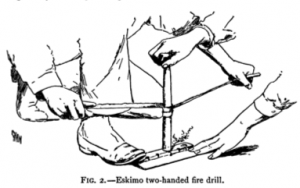 So I go to JSTOR and do a similar search, looking for only “content I can access” and pick up the first thing that’s pre-1923 which is an article about Aboriginal fire making from American Anthropologist in 1890. I click through and agree to the Terms of Service which is almost 9000 words long. Only the last 260 words really apply to EJC. Basically I’ve agreed to use it non-commercially (librarian.net accepts no advertising, I an in the clear) and not scrape their content with bots or other devices. I’ve also seemingly acquiesced to credit them and to use the stable URL, though that doesn’t let me deep-link to the page with the image on it, so I’ve crossed my fingers and deep-linked anyhow. I’m still not sure what I would do, contact JSTOR I guess, if I wanted to use this document in a for-profit project. Being curious, I poked around to see if I could find this public domain document elsewhere and sure enough, I could.
So I go to JSTOR and do a similar search, looking for only “content I can access” and pick up the first thing that’s pre-1923 which is an article about Aboriginal fire making from American Anthropologist in 1890. I click through and agree to the Terms of Service which is almost 9000 words long. Only the last 260 words really apply to EJC. Basically I’ve agreed to use it non-commercially (librarian.net accepts no advertising, I an in the clear) and not scrape their content with bots or other devices. I’ve also seemingly acquiesced to credit them and to use the stable URL, though that doesn’t let me deep-link to the page with the image on it, so I’ve crossed my fingers and deep-linked anyhow. I’m still not sure what I would do, contact JSTOR I guess, if I wanted to use this document in a for-profit project. Being curious, I poked around to see if I could find this public domain document elsewhere and sure enough, I could.
- Wiley, the original publisher has the article available with no JSTOR preconditions.
- Google Books has it both available and not-available depending how you look for it. Readable online, downloadable if you really fish around for it. Google has nearly identical language to JSTOR: use this non-commercially, don’t scrape content or use bots, leave Google’s watermark intact. Hathi Trust has a discovery layer for this material as well and they provide this concise explanation of how “public domain, Google digitized” is different from the public domain. Seventeen different types of rights, whoo-wee!
- Worldcat shows me how to get this from a participating library
- The Internet Archive has a copy, though it was a little tough to find, and it’s an OCRed version of the Google Books document that’s been ported to their interface, though this one says NO_KNOWN_COPYRIGHT (all caps not mine).
At that point, I quit looking. I found a copy that was free to use. This, however, meant that I had to be good at searching, quite persistent and not willing to take “Maybe” as an answer to “Can I use this content?” I know that when I was writing my book my publishers would not have taken maybe for an answer, they were not even that thrilled to take Wikimedia Commons’ public domain assertions.
As librarians, I feel we have to be prepared to find content that is freely usable for our patrons, not just content that is mostly freely usable or content where people are unlikely to come after you. As much as I’m personally okay being a test case for some sort of “Yeah I didn’t read all 9000 words on the JSTOR terms and conditions, please feel free to take me to jail” case, realistically that will not happen. Realistically the real threat of jail is scary and terrible and expensive. Realistically people bend and decide it’s not so bad because they think it’s the best they can do. I think we can probably do better than that.
when good librarians go bad, genuine options in librarianship
I upgraded WordPress this week. Please let me know if anything is wonky.
This is an exchange from facebook with names changed to protect the innocent. It highlights something I find happening to me in the library world all the time — having to balance solving the problem with following the rules. The person posting the update needed an article. The rules said they had to pay $31.50 for an article. This didn’t pass the sanity check [“$30 for one article from a journal, that’s crazy!”] and the librarian was grousing. They’re also grousing to a huge network of librarians, many of whom had free [or, paid for by their institution] access to the same content. I saw Nicole speak in Florida this past week and one of the quotes she repeats again and again is “With enough eyeballs, all bugs are shallow” meaning that a particular coding problem that might vex one or two programmers is unlikely to vex, say, a thousand programmers.
My Jessamyn corollary to this is “With enough libraries, all content is free.” That is to say… if the world was one big library and we all had interlibrary loan at that library, we could lend anything to anyone. The funding structures of libraries currently mean that in many cases we’re duplicating [and paying for] content that we could be sharing. This is at the heart of a lot of the copyright battles of today and, to my mind, what’s really behind the EBSCO/Gale/vendors. Time Magazine is losing money and not having a good plan for keeping their income level up, decides to offer exclusive contracts to vendors and allows them to bid. EBSCO wins, Gale loses. Any library not using EBSCO loses. Patrons lose and don’t even know they’ve lost.
When I was blogging for BoingBoing I often came across content that I didn’t have access to. I was also confronted with, in many cases, unreasonable fees requested [$9.95 for 100 words, really?]. Me being me, I could always find a librarian with access to, say the Times Online archive, or old articles in JSTOR. But I also felt it was cheating. But I was also annoyed that being resourceful is also somehow cheating. And I knew that many of my patrons with fewer resources would just pony up. Where do we draw the line between enforcing other people’s rules and solving problems with our patrons? Now that we’re getting more and more networked, this whole idea of local content works for some things [historical photos, town history] and not for others [journal articles that are held in thousands of libraries worldwide]. Do we have a plan for moving forward?
a few new interpretations of the Library Bill of Rights
While I wish, as per usual, that the URL and the web page were friendlier and that I could see what changes were made, ALA has released a few more council-approved interpretations of the Library Bill of Rights, two new, two revised, one new from Midwinter. I’ll link to the new stuff individually as well.
- Minors and Internet Interactivity (new)
- Importance of Education to Intellectual Freedom (new)
- Access to Digital Information, Services, and Networks (revised)
- Labeling and Rating Systems (revised)
- Services to People with Disabilities (new from Midwinter)
Some discussion in the comments over at LISNews.

